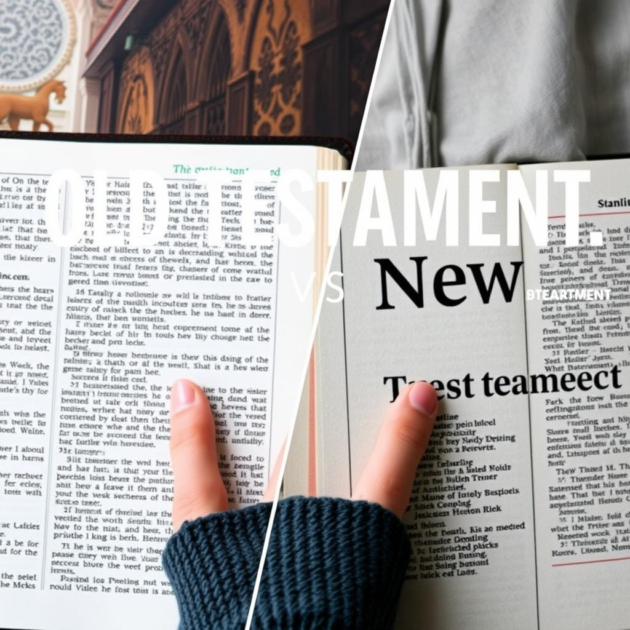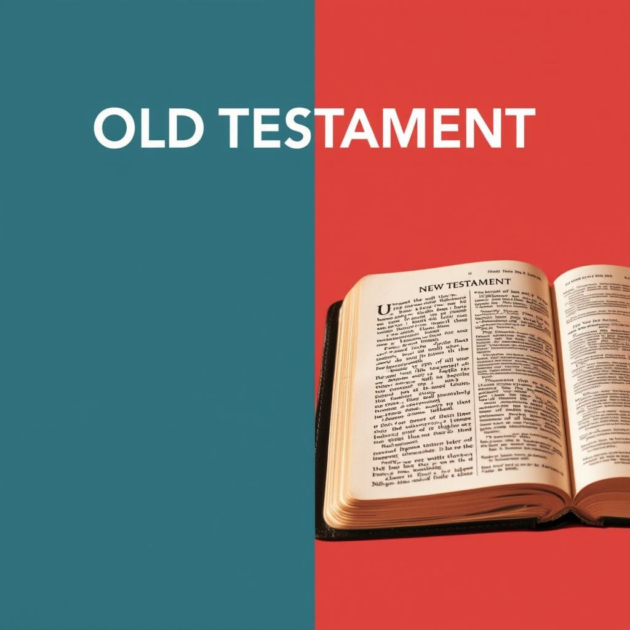As Christians, we often find ourselves navigating the complexities of the Bible, trying to understand the nuances of the Old and New Testaments. While both testaments are essential to the Christian faith, there are significant differences between them that can be confusing for many believers. In this article, we will delve into the key differences between the Old and New Testaments, exploring the historical context, theological themes, and practical applications of each.
Before we dive into the differences, let’s take a moment to appreciate the significance of the Bible as a whole. As the renowned Christian author, C.S. Lewis, once said:
“The Bible is a book that reads us, not the other way around. It is a book that reveals to us the deepest secrets of our own hearts, and the heart of God.”
Understanding the Old Testament
The Old Testament, comprising 39 books, tells the story of creation, the history of the Israelites, and the prophetic promises of a Messiah to come. The Old Testament is characterized by:
- Law and Covenant: The Old Testament establishes the foundation of God’s relationship with humanity, outlining the laws and commandments that govern this covenant.
- History and Prophecy: The Old Testament records the history of the Israelites, from creation to the Babylonian exile, and includes prophetic declarations of a future Messiah.
- Rituals and Sacrifices: The Old Testament describes the various rituals and sacrifices that were part of the Israelites’ worship, including the tabernacle and temple services.
Understanding the New Testament
The New Testament, consisting of 27 books, focuses on the life, teachings, death, and resurrection of Jesus Christ, as well as the spread of Christianity in the 1st century. The New Testament is marked by:
- Gospel and Grace: The New Testament introduces the concept of salvation by faith in Jesus Christ, emphasizing the gift of grace and the importance of personal relationship with God.
- Church and Community: The New Testament describes the establishment of the early Christian church, highlighting the importance of community, fellowship, and discipleship.
- Eschatology and Hope: The New Testament looks forward to the return of Jesus Christ, offering hope and encouragement to believers in the face of persecution and uncertainty.
Key Differences Between the Old and New Testaments
The following table summarizes some of the main differences between the Old and New Testaments:
| Category | Old Testament | New Testament |
|---|---|---|
| Focus | History, Law, Prophecy | Gospel, Grace, Church |
| Covenant | Old Covenant (Law) | New Covenant (Grace) |
| Worship | Rituals, Sacrifices | Spirit-led, Personal Relationship |
| Salvation | Works-based (Law) | Faith-based (Grace) |
| Community | Israelites | Global Church |
Top 10 Most Misunderstood Bible Verses (And What They Really Mean)

As we explore the differences between the Old and New Testaments, it’s essential to address some of the most misunderstood Bible verses. Here are ten examples:
- Leviticus 18:22 – Often cited as a condemnation of homosexuality, this verse is actually part of a larger context of pagan practices and idolatry.
- Psalm 137:9 – This verse, which appears to condone violence against children, is actually a poetic expression of sorrow and outrage in response to the Babylonian destruction of Jerusalem.
- Matthew 5:38-42 – Jesus’ teaching on turning the other cheek is not about passivity, but about choosing not to escalate violence and instead responding with love and compassion.
- Romans 13:1-7 – This passage is often misused to justify submission to oppressive governments, but it actually emphasizes the importance of respecting authority while also advocating for justice and compassion.
- Revelation 20:1-6 – The concept of a literal 1,000-year reign of Christ is not supported by the biblical text, which instead uses symbolic language to describe the ultimate triumph of God over evil.
The Old Testament, also known as the Hebrew Bible, tells the story of God’s covenant with the nation of Israel. It spans from creation to the period just before the coming of Jesus. Think of it like the foundation of a magnificent building. Without a solid foundation, the structure cannot stand. The Old Testament lays the groundwork for the coming of Christ, foreshadowing His arrival through prophecies, symbols, and types.
Here are some of the key aspects I’ve found most compelling:
- God’s Covenant with Israel: The central theme is God’s covenant with Abraham and his descendants. This covenant promises blessings and a special relationship with God, contingent upon their obedience to His commands. I’ve learned that this covenant is not just a historical agreement; it’s a testament to God’s faithfulness and His desire for a relationship with humanity.
- The Law: The Old Testament contains a vast collection of laws, given through Moses. These laws covered every aspect of life, from moral principles to dietary regulations to ceremonial practices. While seemingly restrictive at times, the Law served to define Israel as a distinct people, set apart for God’s purpose. It was a way for them to demonstrate their love and obedience.
- Prophecy: The Old Testament is filled with prophecies about the coming Messiah. These prophecies, uttered by prophets like Isaiah, Jeremiah, and Daniel, foretold details about the Messiah’s birth, life, death, and resurrection. I find it incredibly moving to see how Jesus perfectly fulfilled these ancient prophecies, solidifying His identity as the promised Savior.
- Sacrifices: The sacrificial system outlined in the Old Testament was a crucial part of Israel’s worship. Animals were offered as sacrifices to atone for sins. While a seemingly brutal practice to our modern sensibilities, it served as a powerful symbol of the cost of sin and the need for atonement. It pointed forward to the ultimate sacrifice of Jesus Christ, who would take away the sins of the world.
- The Story of God’s People: The Old Testament chronicles the triumphs and failures of the Israelites, their moments of faith and their descent into idolatry. These stories are not just historical accounts; they are powerful lessons about human nature, God’s patience, and the consequences of disobedience. I see in their stories a reflection of my own struggles and a reminder of God’s unwavering grace.
The New Testament: The Fulfillment of Promise
The New Testament, on the other hand, focuses on the life, death, and resurrection of Jesus Christ, and the establishment of the Christian church. It is built upon the foundation laid by the Old Testament. Think of it as the glorious superstructure, the crowning achievement of God’s plan. It reveals the fulfillment of the prophecies and the culmination of God’s redemptive work.
Here are some key differences that have shaped my understanding:
- Jesus Christ: The Central Figure: The New Testament revolves entirely around Jesus Christ. He is the Messiah prophesied in the Old Testament, the Son of God incarnate, who came to redeem humanity from sin. Understanding His teachings, miracles, death, and resurrection is the core of my Christian faith.
- Grace vs. Law: While the Old Testament emphasizes adherence to the Law, the New Testament emphasizes grace through faith in Jesus Christ. While the Law revealed our sinfulness and our inability to perfectly obey God, grace offers forgiveness and reconciliation through Christ’s sacrifice. I’ve come to understand that grace is not a license to sin, but rather a motivation to live a life pleasing to God out of gratitude for His undeserved favor.
- A New Covenant: The New Testament introduces a new covenant, established through the blood of Jesus Christ. This covenant is not based on adherence to laws but on faith in Christ. It offers forgiveness, reconciliation, and eternal life to all who believe, regardless of their background or ethnicity.
- The Holy Spirit: The Holy Spirit, promised by Jesus, is a central figure in the New Testament. He empowers believers to live a life of holiness, guides them in truth, and equips them for service. I’ve experienced the power of the Holy Spirit in my own life, guiding me, comforting me, and empowering me to share the Gospel with others.
- The Church: The New Testament describes the formation and growth of the Christian church, a community of believers united by their faith in Christ. The church is called to be a light to the world, spreading the Gospel and demonstrating God’s love through acts of service and compassion. I find strength and encouragement in being part of this community, sharing my faith and supporting others on their spiritual journey.
Bridging the Gap: Harmony and Complementarity
It’s important to understand that the Old and New Testaments are not contradictory but rather complementary. The New Testament fulfills the promises made in the Old Testament, revealing the deeper meaning and purpose of God’s plan. One does not negate the other; they work together to present a complete picture of God’s love and redemption.
- Prophecy and Fulfillment: The New Testament demonstrates how Jesus perfectly fulfilled the prophecies of the Old Testament, confirming His identity as the Messiah.
- Law and Grace: While the New Testament emphasizes grace, it does not abolish the Law. Rather, it fulfills the Law, revealing its true purpose as a guide to righteousness and a reflection of God’s character.
- Old Covenant and New Covenant: The New Covenant builds upon the Old Covenant, offering a deeper and more personal relationship with God through faith in Jesus Christ.
Why This Matters for Every Christian

Understanding the relationship between the Old and New Testaments is crucial for a well-rounded Christian faith. It allows us to:
- Appreciate the Full Scope of God’s Plan: Seeing how the Old Testament foreshadows the coming of Christ and how the New Testament fulfills those prophecies deepens our appreciation for God’s wisdom and faithfulness.
- Understand the True Meaning of the Gospel: By understanding the Old Testament context, we can better grasp the significance of Jesus’ sacrifice and the grace offered through faith in Him.
- Live a More Meaningful Christian Life: A deeper understanding of the Bible empowers us to live a life of obedience, gratitude, and service, reflecting God’s love to the world.
- Discern Truth from Error: A solid foundation in both testaments helps us to discern true doctrine from false teachings and to stand firm in our faith.
Frequently Asked Questions
Q: Is the Old Testament still relevant for Christians today? A: Yes, the Old Testament provides essential background and context for understanding the New Testament and the Christian faith as a whole.
Q: How do I reconcile the differences between the Old and New Testaments? A: By recognizing the historical and cultural contexts of each testament, as well as the progressive nature of God’s revelation, we can appreciate the unique contributions of each testament to our understanding of God and the Christian faith.
Q: What is the significance of the New Covenant in the New Testament? A: The New Covenant, established through the death and resurrection of Jesus Christ, offers salvation by faith and provides a new basis for relationship with God, one that is characterized by grace, forgiveness, and personal intimacy.
Practical Applications
As we explore the differences between the Old and New Testaments, here are some practical takeaways for Christian living:
- Emphasize grace over law: Recognize that our relationship with God is based on faith and grace, rather than attempts to earn salvation through good works.
- Cultivate a personal relationship with God: Prioritize spiritual practices like prayer, Bible study, and worship, which help us deepen our connection with God.
- Engage in community and discipleship: Participate in a local church or fellowship, and seek out mentors and friends who can support and encourage you in your faith journey.
In conclusion, both the Old and New Testaments are essential parts of the Christian Bible, each offering unique insights into God’s character and His plan for humanity. By studying both testaments, understanding their differences, and appreciating their harmony, we can deepen our faith, strengthen our understanding of the Gospel, and live a more meaningful Christian life. My journey of understanding the Old and New Testaments has been deeply rewarding, and I encourage you to embark on your own exploration of these sacred texts. The treasures you discover will undoubtedly enrich your faith and bring you closer to God.

